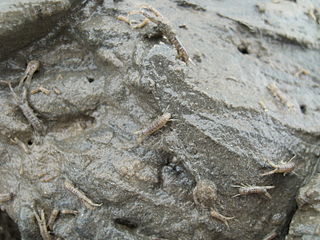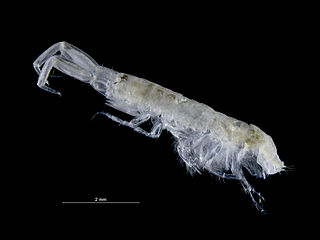
Corophiidae is a family of amphipods, containing the following genera:

Corophium volutator is a species of amphipod crustacean in the family Corophiidae. It is found in mudflats of the northern Atlantic Ocean. It is native to the north-east Atlantic Ocean, and has been introduced to the north-west Atlantic.
Corophium arenarium is a small European amphipod crustacean of the family Corophiidae. It looks very similar to C. volutator.
Corophium multisetosum is a small European amphipod crustacean of the family Corophiidae.

Corystes cassivelaunus, the masked crab, helmet crab or sand crab, is a burrowing crab of the North Atlantic and North Sea from Portugal to Norway, which also occurs in the Mediterranean Sea. It may grow up to 4 centimetres or 1.6 inches long. The name "masked crab" derives from the patterns on the carapace which resemble a human face, in a similar manner to heikegani. It is the only species in the genus Corystes.

Galathea strigosa is a species of squat lobster in the family Galatheidae. It is found in the northeast Atlantic Ocean, from the Nordkapp to the Canary Islands, and in the Mediterranean Sea and Red Sea. It is edible, but not fished commercially. It is the largest squat lobster in the northeast Atlantic, reaching a length of 90 millimetres (3.5 in), or a carapace length of 53 mm (2.1 in), and is easily identified by the transverse blue stripes across the body.

Amphilochus neapolitanus also known as “algae louse” is a species of amphipod crustacean up to 4 millimetres (0.16 in) long. It lives at depths of up to 80 metres (260 ft) throughout the Mediterranean Sea and Black Sea, and in parts of the eastern Atlantic Ocean from the North Sea to North Africa. It is usually found on rocks among algae, where it feeds by grazing.

Leucothoe incisa is an amphipod in the family Leucothoidae. It grows up to 7 millimetres (0.28 in) long, and is whitish in colour, but a yellowish green along the back, with intensely red eyes. It lives at depths of up to 60 metres (200 ft) along the Atlantic coast of Europe from the Mediterranean Sea to Scotland, and in the North Sea. It is part of group of sibling species, together with Leucothoe lilljeborgi and Leucothoe occulta.

Neptunea contraria is a left-handed species of sea snail, a marine gastropod mollusk in the family Buccinidae, the true whelks.

Boreotrophon clathratus, common name the clathrate trophon, is a species of sea snail, a marine gastropod mollusk in the family Muricidae, the murex snails or rock snails.

Monocorophium is a genus of amphipod crustaceans.
Crassicorophium crassicorne is a species of amphipod crustacean. It lives in shallow subtidal muddy sand and may grow up to 5 millimetres (0.20 in) long. C. crassicorne occurs on American and European coasts from Norway to the Black Sea.
Medicorophium affine is a species of amphipod crustacean. It is a small species which burrows in bottom sediments, between 10 and 80 metres deep. It occurs on coasts of Northern Europe.
Chelicorophium curvispinum is a species of amphipod crustacean. It lives in salt, brackish and fresh water, and may reach 6 millimetres (0.24 in) in length. It occurs in the Caspian Sea, the Black Sea and adjoining rivers, and in river systems emptying into the southern Baltic and North Sea.

Apocorophium lacustre is a species of amphipod crustacean. It lives in nearly fresh water; it is white and up to 6 mm long. It occurs mainly on the Atlantic coast of North America, the North Sea and the Baltic.

Nototropis falcatus is a species of amphipod crustacean. It is whitish in colour, with brown patches, and grows to a total length of around 7 mm (0.3 in). It lives on soft sediment such as fine sand at depths of 10 to 50 metres, from northern Norway to the west coast of Ireland, including the North Sea, and as far south as the southern Bay of Biscay.
Jassa marmorata is a species of tube-building amphipod. It is native to the northeast Atlantic Ocean but has been introduced into northeast Asia. J. marmorata are greyish in colour with reddish brown markings. The can grow to a length of up to 10 millimetres (0.39 in). They are generally found in fouling communities and intertidal areas where they build tubes of detritus and algae fragments using silky mucus secretions. They are remarkable for having two distinct morphs of males with two different mating strategies. The 'major' morphs are fighter males, while the 'minor' morphs are sneaker males.

Caprella linearis is a species of skeleton shrimp in the genus Caprella. It is native to the North Atlantic, North Pacific, and the Arctic Ocean. It closely resembles Caprella septentrionalis with which it shares the same geographical distribution.

Caprella equilibra is a species of skeleton shrimp in the family Caprellidae. It lives among other organisms on the seabed and occurs in both shallow and deep water in many parts of the world.

Boltenia echinata, commonly known as the cactus sea squirt, is a species of tunicate, a marine invertebrate in the genus Boltenia of the family Pyuridae. It is native to the Arctic Ocean and the northern Atlantic Ocean.














